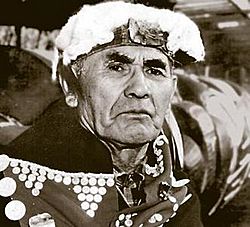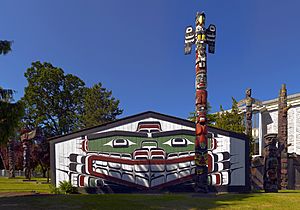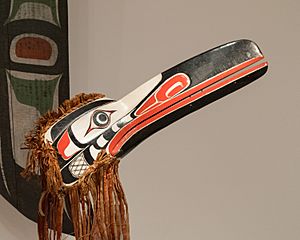Mungo Martin facts for kids
Quick facts for kids
Mungo Martin (Nakapenkim)
|
|
|---|---|
 |
|
| Born | 1879 Fort Rupert, British Columbia, Canada
|
| Died | August 16, 1962 (aged 82-83) Victoria, British Columbia, Canada
|
| Nationality | Kwakwaka'wakw |
| Known for | Sculptor, Painter |
| Movement | Northwest Coast art |
| Patron(s) | Royal British Columbia Museum |
Chief Mungo Martin, also known as Nakapenkem (which means Potlatch chief "ten times over"), or Datsa (meaning "grandfather"), was a very important artist. He was famous for his work in the Northwest Coast style of art. He belonged to the Kwakwaka'wakw Aboriginal people, who live in British Columbia and on Vancouver Island in Canada.
Mungo Martin was especially good at carving wood and painting. He also wrote and sang many songs.
Contents
Early Life and Family
Martin was born in 1879 in Fort Rupert, British Columbia. His parents were from the Kwakwaka'wakw Nation. His father, Yaxnukwelas, was an important leader from Gilford Island.
His mother, Q'omiga (also known as Sarah Finlay), was the daughter of a Kwakwaka'wakw woman and a Scottish man who worked for the Hudson's Bay Company. Mungo's father died when Mungo was a teenager. His mother then married Yakuglas, also known as Charlie James. Mungo's mother wanted him to become a woodcarver and a songwriter. She even held special ceremonies to help this happen.
Growing Up with Kwakwaka'wakw Culture
From a young age, Mungo Martin took part in the ceremonies, songs, art, and traditions of his Kwakwaka'wakw people. This helped him learn everything about the Northwest Coast art style. He used this knowledge in his designs, carvings, paintings, and the songs he made throughout his life.
Martin grew up with the potlatch tradition, which was a very important part of Kwakwaka'wakw culture. A potlatch is a special ceremony where gifts are given away to show wealth and status.
Later in his life, Martin helped keep his culture alive. He met with other famous artists like Tom Omhid, Willie Seaweed, and Dan Cranmer. Together, they taught new people about Kwakwaka'wakw ceremonies. He also shared 124 songs with Ida Halpern, a Canadian expert who studies music from different cultures. This helped make sure his traditions would be remembered by future generations.
To earn money, Mungo Martin worked as a commercial fisherman for a while. He later married Abayah Martin, who was also an artist. She was skilled at weaving special curtains and aprons for ceremonies.
Mungo Martin made and sang songs his whole life. He recorded them with people like the Hawthornes. He loved music and folk songs. He even learned songs from other tribes, like the Navajo, from his relative Bob Harris. Bob had met these other Native peoples at the Chicago World Exhibition. Martin also learned Japanese folk songs from other Kwakwaka'wakw people who had traveled to Japan on ships that hunted seals.
Becoming a Professional Artist

When Mungo was a boy, he learned carving from his father's brother. His stepfather, Charlie James, who was a well-known artist from the Northwest, helped him make his natural talent even better. Martin became one of the first traditional artists to use many different carving and painting styles from the Northwest Coast. Around 1900, he carved his first totem pole for a customer in Alert Bay. He called it "Raven of the Sea."
Martin also fixed and restored many carvings, totem poles, masks, and other ceremonial items. He became famous for holding the first public potlatch after the Canadian government had banned them in 1885. He even received a medal from the Canadian Council for his work.
In 1947, the Museum of Anthropology at UBC hired Martin. He worked there fixing old artworks and making copies. During this time, Martin lived on the university campus. He continued to paint and carve smaller pieces at night.

Working with Museums and Building Totem Poles
In 1952, the Royal British Columbia Museum in Victoria, British Columbia hired Martin. His job was to create Northwest Coastal Art for displays and as examples. One of his biggest projects was a huge totem pole carved from cedar. It was 160 feet tall! This pole was put up in 1956 and stood until the year 2000.
He also built Wawadit'la, a Kwakwaka'wakw "big house," at Thunderbird Park, right in front of the museum. While working there, he became good friends with an American expert named Bill Holm. Martin even designed a Kwakwaka'wakw big house on the coast of Washington State.
Mungo Martin also designed and was the main carver of the famous Totem Pole in Windsor Great Park in the United Kingdom. This Totem Pole was a gift from the people of Canada to Queen Elizabeth II in June 1958. It stands 100 feet high, with one foot for every year, to celebrate 100 years of British Columbia. The figures on the pole represent mythical ancestors of different clans. The pole was carved from a single log of Western Red Cedar, which was 600 years old and weighed 27,000 pounds.
Teaching New Artists
When Martin started working for the museum in Victoria, his son David and his family, along with relatives Henry and Helen Hunt, moved to James Bay near Thunderbird Park. Helen was Mungo's wife's granddaughter. Mungo's son David, Henry Hunt, and even Henry's son Tony (who was only twelve at the time) became his students.
Martin taught his son David his carving skills, but David sadly passed away in 1959. Henry's sons, Stanley Hunt and Richard Hunt, also became professional carvers, continuing the family tradition.
It is believed that Martin also taught the famous Haida sculptor Bill Reid. They likely spent time together on a project at the Museum of Anthropology at UBC. Mungo also mentored Doug Cranmer, who became a very talented artist with his own unique style. Doug was the grandson of Mungo's wife Abaya'a, and the son of Mungo's first cousin, Dan Cranmer. Mungo also mentored Godfrey Stephens, a painter and sculptor, whom he met in Victoria in the 1950s.
Later Years and Legacy
Mungo Martin continued to work on his carvings in his later years. He was very important in the Northwest Coastal Art world because of the huge amount of art he created.
He passed away on August 16, 1962, at the age of eighty-three in Victoria. A Canadian Navy ship carried him to be buried in Alert Bay. His wife Abaya'a died the following year. Mungo Martin's work helped keep the rich art and traditions of the Kwakwaka'wakw people alive for future generations.
See also

